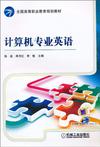计算机专业英语
出版时间:2010-8 出版社:机械工业出版社 作者:陈嘉 等主编 页数:240
前言
计算机技术是当今发展最快的技术之一,计算机的使用已经非常普及了。大多数软件的帮助文档是英文的,屏幕上看到的也都是英文提示和说明,已经渗透到各行各业、学习生活的Intemet上的信息大多数用英文表示。无论是学习计算机科学与技术,还是使用计算机软硬件产品,都离不开对计算机英语的熟练掌握。因此,每个从事计算机科学与技术的学习、教学、科研、工程技术及经营管理的人员都必须具备良好的英语能力,达到一定的计算机专业英语水平,才能跟上计算机技术的飞速发展。 本书面向计算机应用及相关专业,强调与计算机专业课程的协调性。在教材编写上,本书没有过分强调抽象的语法和晦涩的术语,而是更多地关注计算机应用以及对社会和生活的影响。在选材上,除了计算机基础知识、软硬件结构体系,本书还涵盖了网络技术、计算机安全、计算机应用、搜索引擎以及计算机英文文档等方面的专业知识。 本书共有21个单元(Unit),分为8个部分。第1部分是第1单元,介绍计算机基础知识;第2部分是第2~4单元,介绍计算机硬件的基本知识,主要包括计算机硬件组成、中央处理器、计算机外围设备;第3部分是第5~7单元,介绍计算机软件的基础知识,主要包括计算机软件基础、计算机操作系统、计算机应用软件;第4部分是第8~10单元,介绍计算机网络知识,主要包括计算机网络技术、Intemet、Intemet 2;第5部分是第ll~13单元,介绍计算机安全知识,主要包括计算机病毒、防火墙工作原理、计算机加密;第6部分是第14~16单元,介绍计算机应用方面的知识,主要包括数据库应用、多媒体技术、电子商务的应用;第7部分是第17~19单元,介绍网络搜索引擎技术,主要包括网络搜索引擎技术原理、关于Microsoft.com的搜索、搜索引擎的类型;第8部分是第20~21单元,主要包括计算机文档和Windows帮助文档。每一单元后面均有难点注释、关键术语的定义、习题以及阅读材料和计算机英语相关知识介绍,有利于读者对课文的理解和掌握,提高对计算机专业英语的阅读和理解能力。 本书由陈嘉、周月红、李敏任主编,孟大伟、苏福振、张红娟任副主编,郭晓燕、王飞、王晓玲等编著,参加编写的作者还有江天仿、何俨、朱晓波、郭璐青、贾燕玲、李晓娟、魏蔚、张建华、姜超、范辉、彭春艳。全书由陈嘉、周月红统稿,刘瑞新主审。 本书可作为高职高专院校计算机专业的计算机英语课程的教材,也可作为自学人员和网站开发人员的技术参考书。 由于编者水平有限,书中错误与疏漏之处在所难免,敬请读者批评指正。
内容概要
本书是计算机专业英语教材。全书分为8个部分,21个单元,涵盖了计算机基础知识、软硬件结构体系、网络技术、计算机安全、计算机应用、搜索引擎以及计算机英文文档等方面的专业知识。每一单元均有难点注释、关键术语的定义、习题以及计算机英语的翻译和写作技巧,有利于读者对课文的理解和掌握,提高对计算机专业英语的阅读和理解能力。 本书内容丰富、选材新颖、面向应用,以提高学生对计算机英语的阅读及理解能力、掌握计算机专业英语的翻译技巧和写作方法为目标,难易适中,通俗易懂,实用性强,适合作为高职高专院校计算机专业计算机英语课程的教材,也可供计算机相关专业技术人员学习和参考。
书籍目录
出版说明前言Unit1 Introduction to Computers Part I Text Part II Exercises Part III Reading Material Part IV Reading Skills I Unit2 Fundamentals of Computer Hardware Part I Text Part II Exercises Part III Reading Material Part IV Reading Skills II Unit3 Central Processing Unit28 Part I Text Part II Exercises Part III Reading Material Part IV Reading Skills III Unit4 Computer Peripherals Part I Text Part II Exercises .Part III Reading Material Part IV Reading Skills IV Unit5 Fundamentals of Computer Software Part I Text Part II Exercises Part III Reading Material Part IV Reading Skills V Unit6 System Software Part I Text Part II Exercises Part III Reading Material Part IV Reading Skills VI Unit7 Application Software Part I Text Part II Exercises Part III Reading Material Part IV Reading Skills VII Unit8 Computer Network Knowledge Part I Text Part II Exercises Part III Reading Material Part IV Reading Skills Ⅷ Unit9 The Internet Part I Text Part II Exercises Part III Reading Material Part IV Word Building I Unit10 Internet Part I Text Part II Exercises Part III Reading Material Part IV Word Building II Unit11 Antivirus Technology Part I Text Part II Exercises Part III Reading Material Part IV Translation Skills I Unit12 Computer Firewalls Part I Text Part II Exercises Part III Reading Material Part IV Translation Skills II Unit13 Encryptions Part I Text Part II Exercises Part III Reading Material Part IV Translation Skills III Unit14 Database Overviews Part I Text Part II Exercises Part III Reading Material Part IV Translation Skills IV Unit15 Multimedia Technologies Part I Text Part II Exercises Part III Reading Material Part IV Translation Skills V Unit16 Electronic Commerce Part I Text Part II Exercises Part III Reading Material Part IV Translation Skills VI Unit17 Search Engine Technologies Part I Text Part II Exercises Part III Reading Material Part IV Translation Skill VII Unit18 About the Searching of Microsoft.com Part I Text Part II Exercises Part III Reading Material Part IV Writing Skills I Unit19 Types of Search Engines Part I Text Part II Exercises Part III Reading Material Part IV Writing Skills II Unit20 Computer Documents Part I Text Part II Exercises Part III Reading Material Part IV Writing Skills III Unit21 Windows Help Documents Part I Text Part II Exercises Part III Reading Material Part IV Writing Skills IV 参考文献
章节摘录
It's hard to assign a worthwhile definition to each type of computer because definitions can getbogged down in potentially confusing technical jargon. Nevertheless, the following definitions cansuffice: 1 ) A supercomputer can handle gigantic amounts of scientific computation. It's usuallymaintained in a special room or environment, and may be about 50,000 times faster than a micro-computer. As a user in business, you probably would not have contact with a supercomputer.However, you might if you worked in the areas of defense and weaponry, weather forecasting,scientific research, at one of several large universities, or for the National Aeronautics and SpaceAdministration. 2) A mainframe computer is a large computer, usually housed in a controlled environment,that can support the processing requirements of hundreds or thousands of users and computerprofessionals. If you go to work for an airline, a bank, a large insurance company, a largeaccounting company, a large university, or the Social Security Administration, you will likely havecontact, through your individual workstation, with a mainframe computer. 3 ) A minicomputer, also known as a midsize or low-end mainframe computer, is similar to butless powerful than a mainframe computer. It can support 2 to 50 users and computer professionals.Minicomputers and mainframe computers can work much faster than microcomputers and havemuch more storage locations in main memory. Many small and medium-sized companies today useminicomputers, so if you go into the business world, you will have good chances to contact with aminicomputer.
图书封面
评论、评分、阅读与下载
用户评论 (总计1条)
- 非常好 考研用的
